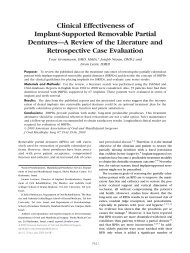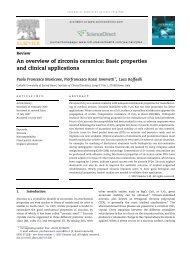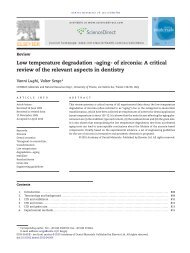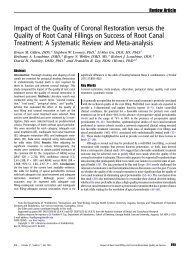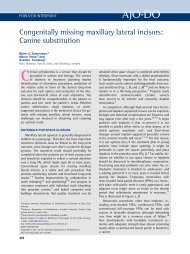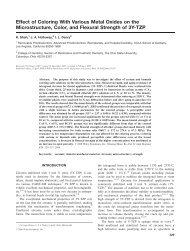Congenitally missing maxillary lateral incisors: Restorative ...
Congenitally missing maxillary lateral incisors: Restorative ...
Congenitally missing maxillary lateral incisors: Restorative ...
You also want an ePaper? Increase the reach of your titles
YUMPU automatically turns print PDFs into web optimized ePapers that Google loves.
POINT/COUNTERPOINT 435<br />
<strong>Congenitally</strong> <strong>missing</strong> <strong>maxillary</strong> <strong>lateral</strong> <strong>incisors</strong>:<br />
<strong>Restorative</strong> replacement<br />
Vincent O. Kokich, Jr., a<br />
Greggory A. Kinzer, b and<br />
Jim Janakievski c<br />
Seattle, Wash<br />
As dentists, we are often faced with the question:<br />
to close or not to close? Since <strong>maxillary</strong><br />
<strong>lateral</strong> <strong>incisors</strong> are often congenitally <strong>missing</strong>,<br />
replacement of these teeth raises several important<br />
treatment planning concerns. 1,2 Therefore, it is<br />
beneficial to use an interdisciplinary treatment<br />
approach to obtain the most predictable outcome.<br />
There are multiple treatment options for the<br />
replacement of congenitally <strong>missing</strong> <strong>lateral</strong> <strong>incisors</strong>,<br />
including canine substitution, single-tooth implants,<br />
and tooth-supported restorations. 3-5<br />
Drs Zachrisson, Rosa, and Toreskog beautifully<br />
illustrated the benefits of canine substitution by<br />
presenting the advantages and disadvantages of space<br />
closure as well as the functional and esthetic limitations<br />
that accompany this treatment choice. Like our European<br />
colleagues, our team agrees with the underlying<br />
principle to develop treatment plans that are both conservative<br />
and functional while maintaining excellent<br />
esthetics. However, the esthetic and functional success<br />
of canine substitution ultimately depends on variables<br />
such as malocclusion, crowding, profile, crown shape<br />
and color, and smiling lip level. 4 Also, the amount of<br />
crown reduction that is often required to appropriately<br />
position these teeth esthetically and functionally in 3<br />
planes of space can be excessive. Therefore, the optimal<br />
canine substitution patient is one who has small<br />
canines with crowns that match the shade of the central<br />
<strong>incisors</strong>. Ideally, he or she should also have a nice profile,<br />
a Class II dental relationship, and no crowding in<br />
the mandibular arch. However, many patients do not<br />
meet these criteria, and multiple veneers often need<br />
to be placed on the anterior teeth to overcome the<br />
From the University of Washington, Seattle.<br />
a Affiliate assistant professor, Department of Orthodontics.<br />
b Affiliate assistant professor, Department of Prosthodontics.<br />
c Affiliate assistant professor, Department of Periodontics.<br />
Reprint requests to: Vincent O. Kokich, Jr., 1950 S. Cedar St, Suite E, Tacoma,<br />
WA; e-mail, vkokich2@u.washington.edu.<br />
Am J Orthod Dentofacial Orthop 2011;139:434-45<br />
0889-5406/$36.00<br />
Copyright Ó 2011 by the American Association of Orthodontists.<br />
doi:10.1016/j.ajodo.2011.02.004<br />
esthetic compromise that typically arises. Unfortunately,<br />
by doing this, we start to lose the conservative<br />
nature of the overall treatment. Even though veneers<br />
might be considered “conservative” and “ultrathin,”<br />
they are nonetheless restorations that will need to be<br />
maintained and replaced throughout the young patient’s<br />
life. It is our philosophy that for patients who<br />
do not meet the specific qualifications necessary to<br />
be considered optimal candidates for canine substitution,<br />
an alternative form of treatment must be considered.<br />
<strong>Restorative</strong> treatment alternatives can be divided<br />
into 2 categories: a single-tooth implant and<br />
a tooth-supported restoration. The 3 types of toothsupported<br />
restorations available today are a resinbonded<br />
fixed partial denture (FPD), a cantilevered<br />
FPD, and a conventional full-coverage FPD. The primary<br />
consideration when deciding which option to<br />
choose is conservation of tooth structure. Ideally,<br />
the treatment of choice should be the least invasive<br />
option that satisfies the expected esthetic and functional<br />
objectives. Although any of the 3 restorative<br />
treatment options can be used to achieve predictable<br />
esthetics, function, and longevity, if a treatment option<br />
is used in the wrong patient, the final result<br />
might be less than ideal. Therefore, the orthodontist<br />
should know the final restorative treatment plan to<br />
position the adjacent teeth properly and facilitate<br />
the final restoration.<br />
IMPLANT-SUPPORTED RESTORATIONS<br />
Today, the single-tooth implant has become the<br />
most popular treatment alternative for the replacement<br />
of <strong>missing</strong> teeth. 6-11 Various studies have shown the<br />
successful osseointegration and long-term function of<br />
restorations supported by single-tooth implants. 12-14<br />
In addition to the high success rates, 1 main benefit<br />
of this type of restoration is that it leaves the adjacent<br />
teeth untouched. This is particularly important in<br />
young patients and unrestored dentitions. It is true<br />
that implant-supported restorations are not without<br />
American Journal of Orthodontics and Dentofacial Orthopedics April 2011 Vol 139 Issue 4
Counterpoint 437<br />
potential problems. These problems range from mechanical<br />
complications to biologic changes that can<br />
impact their long-term predictability. However, if the<br />
proper surgical and restorative protocols are followed,<br />
potential complications or esthetic compromises are<br />
minimal. To achieve a stable esthetic and healthy outcome<br />
with dental implants, it is beneficial to understand<br />
their effects on the surrounding hard and soft tissues.<br />
Implant-site development<br />
It is now recognized that implant size and position<br />
play important parts in achieving a stable, esthetic, and<br />
healthy outcome. 15 After implant placement, dimensional<br />
changes in the surrounding crestal bone occur<br />
in both vertical and horizontal dimensions. 16,17 If an<br />
implant is to be used to replace a <strong>missing</strong> <strong>lateral</strong><br />
incisor, the thickness of the alveolus must be<br />
adequate to allow for proper implant placement.<br />
Without the development and eruption of the<br />
permanent <strong>lateral</strong> incisor, the osseous ridge in this<br />
area is typically deficient. If<br />
the permanent canine is<br />
allowed to erupt mesially<br />
through the alveolus into the<br />
<strong>lateral</strong> incisor position, its<br />
large buccolingual width will<br />
influence the thickness of<br />
the edentulous ridge. Then,<br />
after the permanent canine is<br />
orthodontically moved<br />
distally, an increased buccolingual alveolar width is<br />
established. 18 Studies have shown that, if a <strong>lateral</strong> incisor<br />
implant site is developed by this orthodontic tooth<br />
movement, its buccolingual dimension remains stable<br />
over time. 19-21 This is especially beneficial, since an<br />
implant cannot be placed until facial growth is complete.<br />
If the alveolar ridge is not developed through guided<br />
orthodontic eruption of the canine into the <strong>lateral</strong> site,<br />
then the edentulous site will typically be deficient in the<br />
orofacial dimension. Positioning dental implants in<br />
a narrow ridge requires deeper placement to prevent<br />
a bony dehiscence and also results in a thin layer of<br />
bone on the facial aspect, both of which will have a negative<br />
impact on the surrounding soft tissues. 14,22-24<br />
Establishment of the biologic width or bone<br />
remodeling of the thin buccal bone will inevitably<br />
lead to show-through of both the implant body and<br />
the abutment, resulting in an unesthetic cyanotic color<br />
of the soft tissue, gingival recession, and abutment exposure.<br />
Esthetic assessments have noted that, for an<br />
optimal outcome, the facial contour should mimic<br />
In addition to the high success<br />
rates, 1 main benefit of this type of<br />
restoration is that it leaves the<br />
adjacent teeth untouched. This is<br />
particularly important in young<br />
patients and unrestored dentitions.<br />
that of a natural tooth root eminence and have a similar<br />
soft-tissue color and texture. 25,26 Therefore, alveolar<br />
ridge augmentation for both implant support and for<br />
what has been referred to as “contour augmentation”<br />
is necessary to provide a stable overlying esthetic softtissue<br />
framework for the implant restoration. 27,28 If<br />
this is not performed, although the implant might be<br />
integrated, the esthetic result could be less than ideal.<br />
Although darkening of the soft tissues around implants<br />
can also be caused by the abutment and crown<br />
“shadowing” the gingiva, this effect is minimized with<br />
today’s restorative materials. With the new advances in<br />
abutments and material selections, customized zirconia<br />
implant abutments with all-ceramic restorations can be<br />
used in the anterior to allow more light reflection and<br />
transmission compared with metal. So, even if the tissue<br />
position around implants changes over time, the esthetic<br />
impact would be minimal (Figure 1).<br />
To determine the appropriate size of the implant to<br />
be used, it is important to evaluate the width of the<br />
edentulous space that is created. The deleterious effect<br />
of bone remodeling in the<br />
proximal region beside a dental<br />
implant mentioned by<br />
Zachrisson et al has been observed<br />
as a loss of periodontal<br />
attachment on the adjacent<br />
tooth. 29 It is known that the<br />
loss of the supporting bone<br />
is worse if the implant-totooth<br />
distance is less than<br />
1.5 mm. This results in apical migration of the papillary<br />
tissue, leading to open gingival embrasures and lack of<br />
gingival scallop. 30 Mesiodistally, most <strong>lateral</strong> incisor sites<br />
will be between 5 and 7 mm. Historically, because of the<br />
lack of options regarding implant sizes, the use of standard<br />
diameter 3.75- to 4.0-mm implants was common<br />
in implant therapy. This compromise in proximal implant<br />
positioning led to unfavorable esthetic outcomes.<br />
Today, the use of implants with a narrow diameter or<br />
a platform switch design has been shown to have a positive<br />
effect on the amount of bone remodeling typically<br />
noted with standard implants. 31,32 In addition, normal<br />
papillary dimensions can predictably be achieved with<br />
proper surgical management, since papillary support is<br />
a result of the periodontal attachment on the adjacent<br />
teeth. 33-35 Our colleagues made a strong attempt to<br />
outline the negative esthetic and biologic outcomes of<br />
dental implants. However, it is clear that the current<br />
knowledge regarding dimensional changes after<br />
implant placement can help to avoid these historically<br />
noted unfavorable results.<br />
American Journal of Orthodontics and Dentofacial Orthopedics April 2011 Vol 139 Issue 4
Counterpoint 439<br />
Fig 1. Uni<strong>lateral</strong> agenesis of the <strong>maxillary</strong> left <strong>lateral</strong> incisor with a peg-shaped right <strong>lateral</strong> incisor in an<br />
18-year-old woman. The patient had just completed orthodontic treatment. Moderate-to-advanced facial<br />
ridge resorption was present in the <strong>maxillary</strong> left <strong>lateral</strong> incisor site with gingival asymmetry noted between<br />
the <strong>maxillary</strong> right <strong>lateral</strong> and the 2 central <strong>incisors</strong> (altered passive eruption). Rather than rebracket, it was<br />
decided to restore the <strong>maxillary</strong> left <strong>lateral</strong> incisor site with a single-tooth implant with guided bone regeneration<br />
and perform esthetic crown lengthening on the facial aspects of the 2 right central and <strong>lateral</strong><br />
<strong>incisors</strong> to match the free gingival margin locations of the contra<strong>lateral</strong> teeth. The final result looks<br />
natural with regard to tooth position, gingival margin symmetry, papillae location, and tissue color.<br />
After the appropriate amount of coronal space has<br />
been determined, it is necessary to evaluate the interradicular<br />
spacing. 36 Inadequate space between the root<br />
apices is generally due to improper root angulation.<br />
Therefore, it is important to take a periapical radiograph<br />
of the edentulous area before removing the<br />
orthodontic appliances to confirm the ideal root position<br />
and adequate spacing for future implant placement.<br />
20 Implants, however, cannot be placed until<br />
facial growth is complete. Therefore, monitoring the<br />
eruption in these patients at an early age is important<br />
for optimal implant-site development.<br />
Timing of implant placement<br />
The appropriate time to place an implant is based on<br />
a patient’s facial growth. As the face grows and the<br />
mandibular rami lengthen, the teeth must erupt to remain<br />
in occlusion. Implants cannot erupt. If an implant<br />
is placed before a patient has completed his or her facial<br />
growth, significant periodontal, occlusal, and esthetic<br />
problems can be created. 29,37 Thilander et al 29 noted<br />
the development of infraocclusion of implantsupported<br />
restorations. The patients in that study<br />
were adolescents between 13 and 17 years of age<br />
when the dental implants were placed. Nearly all of<br />
the infraocclusion that was observed occurred during<br />
this period of growth. Historically, hand-wrist radiographs<br />
have been taken to assess growth. However,<br />
they do not predictably determine the completion of facial<br />
growth. The most predictable way to monitor facial<br />
growth is by evaluating serial cephalometric radiographs<br />
taken 6 months to 1 year apart. 18,38 These<br />
radiographs, when superimposed, illustrate any<br />
changes in vertical facial height over the specific time<br />
period. If 2 sequential radiographs show no growth,<br />
then an implant can be placed, and significant<br />
eruption of the adjacent teeth will not be expected. 20<br />
Although changes in tooth position can occur throughout<br />
life, these changes both are multifactorial and show<br />
significant individual variation. Therefore, to help minimize<br />
the long-term impact, the orthodontic treatment<br />
should create good incisor stability to prevent continued<br />
eruption, long-term retention should be used at<br />
night, and the implants should be placed only after<br />
growth is complete. 39 The timing for implant placement<br />
after the end of growth is generally about 20 to 21 years<br />
of age for men and 16 to 17 years of age for girls.<br />
Interim tooth replacement after orthodontics<br />
If implants cannot be placed until facial growth is<br />
complete, the edentulous space must be maintained after<br />
the orthodontic appliances are removed until the<br />
implant can be placed and restored. A removable retainer<br />
with a prosthetic tooth is an easy and efficient<br />
way to replace the <strong>missing</strong> tooth as well as to ensure<br />
postorthodontic retention. This type of retainer works<br />
American Journal of Orthodontics and Dentofacial Orthopedics April 2011 Vol 139 Issue 4
Counterpoint 441<br />
Fig 2. Bi<strong>lateral</strong> agenesis of the <strong>maxillary</strong> <strong>lateral</strong> <strong>incisors</strong> in a 19-year-old woman. The patient had resinbonded<br />
FPDs replacing both <strong>lateral</strong> <strong>incisors</strong>. The restoration had become debonded multiple times and<br />
eventually fractured. Radiographs of the edentulous sites showed convergence of the roots and inadequate<br />
interradicular spacing for implant placement because of the Class III tendency of the malocclusion<br />
that required the previous orthodontics to procline the <strong>maxillary</strong> anterior teeth. (When the <strong>maxillary</strong><br />
<strong>incisors</strong> and canines are aligned, they are proclined or tipped labially. As this happens, the roots of<br />
these teeth converge toward the center of the palate. Unfortunately, tipping these roots labially during<br />
orthodontic treatment is often contraindicated because of the overlying bone support in the anterior<br />
maxilla. The <strong>maxillary</strong> facial cortical plate limits any significant labial root movement of the <strong>maxillary</strong><br />
<strong>incisors</strong>.) Therefore, the treatment chosen for this patient was subepithelial connective tissue ridge<br />
augmentation in the edentulous sites followed by full-coverage cantilever restorations off the canines.<br />
Full coverage was chosen to cover the exposed dentin on the palatal surfaces and alter the facial<br />
esthetics. A cantilevered FPD was the only appropriate restorative option for this patient with her<br />
orthodontic limitations.<br />
well when the period of retention before implant placement<br />
is relatively short. If it will be years before growth<br />
is completed, it is possible to see the roots of the central<br />
incisor and canine converge toward each other during<br />
the retention phase, making future implant placement<br />
difficult or impossible. 40 Therefore, a more appropriate<br />
choice might be a bonded fixed retainer. This could be<br />
as simple as a traditional lingual wire with a prosthetic<br />
tooth or as involved as a laboratory-fabricated<br />
resin-bonded FPD. Regardless of the choice, these<br />
long-term retainers are excellent for maintaining the<br />
final orthodontic position of the canine and the central<br />
incisor.<br />
There are certain patients in whom it is not possible<br />
to place an implant. This could be because the patient<br />
does not want to undergo the necessary<br />
preprosthetic treatment of orthodontics and possible<br />
ridge augmentation to create an ideal implant site.<br />
However, there might also be instances when the appropriate<br />
interradicular spacing cannot be achieved<br />
through orthodontic treatment, even though the coronal<br />
spacing is ideal and the mesiodistal root angulation<br />
is acceptable as confirmed on a panoramic<br />
radiograph. In this situation, an alternate toothsupported<br />
restorative option is required.<br />
TOOTH-SUPPORTED RESTORATIONS<br />
The most conservative tooth-supported restoration<br />
is the resin-bonded FPD, because it leaves the adjacent<br />
teeth relatively untouched. Studies have shown that<br />
the success rate of this type of restoration varies<br />
widely, with debonding the most common cause of<br />
failure. 41-44 Although these restorations can be used<br />
successfully, they have the most stringent criteria that<br />
must be met to ensure their predictability. These<br />
criteria include the position and mobility of the<br />
abutment teeth as well as the overall occlusion. If any<br />
of these criteria are not met, the predictability of the<br />
final restoration will be compromised.<br />
The first 2 contraindications for placing resinbonded<br />
FPDs are deep overbites and proclined teeth,<br />
both associated with a higher incidence of failure. 45<br />
The ideal anterior relationship is a shallow overbite<br />
that allows the maximum surface area for bonding<br />
the retainers and decreases the amount of <strong>lateral</strong> force.<br />
American Journal of Orthodontics and Dentofacial Orthopedics April 2011 Vol 139 Issue 4
Counterpoint 443<br />
However, a shallow anterior relationship cannot be<br />
obtained in every patient, since overbite is dictated by<br />
the height of the posterior cusps. Adequate vertical<br />
overlap of the <strong>incisors</strong> is necessary to disclude the<br />
posterior teeth in excursive movements. Mobility of<br />
the abutment teeth is also a contraindication for<br />
resin-bonded FPDs because it impacts the durability<br />
of the bond in 2 ways. “Directional” mobility problems<br />
arise with <strong>lateral</strong> incisor replacement since a mobile<br />
central incisor and a mobile canine move in different<br />
vectors because of their positions in the arch. This places<br />
increased stress at the bond interface. “Differential”<br />
mobility is when the abutment teeth have different<br />
grades of mobility. Generally, it is the least mobile of<br />
the 2 abutments that will debond because the restoration<br />
tends to move with more mobile abutment. Therefore,<br />
the ideal candidate for a resin-bonded FPD is<br />
a nonbruxer with abutment teeth that are immobile<br />
and upright with a shallow overbite. In these patients,<br />
resin-bonded FPDs can be predictable restorations.<br />
Cantilevered FPD<br />
A more predictable tooth-supported restoration<br />
that overcomes the limitations of a conventional resinbonded<br />
FPD is the cantilevered FPD. 46 Because of its<br />
root length and crown dimensions, the canine is an ideal<br />
abutment for such a restoration. As compared with the<br />
resin-bonded FPD, the success of this restoration does<br />
not depend on the amount of proclination or mobility<br />
of the abutment teeth. If the facial esthetics of the canine<br />
abutment do not need to be altered, the most conservative<br />
cantilevered restoration uses a partial coverage<br />
preparation. 47,48 If the canine requires a change in the<br />
facial contour to enhance the esthetics, then<br />
a conventional full-coverage preparation can be done<br />
to support the cantilevered <strong>lateral</strong> pontic (Figure 2).<br />
The key to the long-term success of a cantilevered bridge<br />
restoration is managing the occlusion on the pontic. 49,50<br />
All contact in excursive movements must be removed<br />
from the cantilever. If eccentric contact remains on the<br />
pontic, the potential risks include loosening of the<br />
restoration, migration of the abutment, and fracture.<br />
Conventional full-coverage FPD<br />
The least conservative of all tooth-supported restorations<br />
is a conventional full-coverage FPD. This restoration<br />
is generally considered the treatment of choice<br />
only when replacing an existing full-coverage bridge<br />
or the adjacent teeth require restoration for structural<br />
reasons such as caries or fracture. However, because<br />
of the amount of tooth preparation required for<br />
a conventional bridge restoration, it is not the ideal<br />
treatment for replacement of <strong>missing</strong> <strong>lateral</strong> <strong>incisors</strong><br />
in young patients.<br />
CONCLUSIONS<br />
There are several restorative options for the replacement<br />
of congenitally <strong>missing</strong> <strong>lateral</strong> <strong>incisors</strong>, including<br />
resin-bonded bridge, cantilevered bridge, and conventional<br />
full-coverage bridge. Each of these restorative<br />
options has a high degree of success if used in the correct<br />
situation. However, in the United States today, the<br />
most common treatment alternative is the single-tooth<br />
implant. The main advantage of this type of restoration<br />
is conservation of tooth structure. It leaves the adjacent<br />
teeth intact. The orthodontist’s role is to provide the<br />
coronal and apical spacing necessary to facilitate any<br />
future restorative dentistry and implant placement.<br />
Therefore, it is imperative to manage these patients<br />
from an interdisciplinary diagnostic and treatment<br />
perspective. By creating that team, the orthodontist, restorative<br />
dentist, and surgeon can produce predictable<br />
and esthetic treatment results.<br />
REFERENCES<br />
1. Graber LW. Congenital absence of teeth: a review with emphasis<br />
on inheritance patterns. J Am Dent Assoc 1978;96:<br />
266-75.<br />
2. Dermaut LR, Goeffers KR, DeSmit AA. Prevalence of tooth agenesis<br />
correlated with jaw relationship and dental crowding. Am J<br />
Orthod Dentofacial Orthop 1986;90:204-9.<br />
3. Kinzer GA, Kokich VO. Managing congenitally <strong>missing</strong> <strong>lateral</strong> <strong>incisors</strong>.<br />
Part I: canine substitution. J Esthet Restor Dent 2005;17:5-10.<br />
4. Kinzer GA, Kokich VO. Managing congenitally <strong>missing</strong> <strong>lateral</strong> <strong>incisors</strong>.<br />
Part II: tooth-supported restorations. J Esthet Restor Dent<br />
2005;17:76-84.<br />
5. Kinzer GA, Kokich VO. Managing congenitally <strong>missing</strong> <strong>lateral</strong> <strong>incisors</strong>.<br />
Part III: single-tooth implants. J Esthet Restor Dent 2005;<br />
17:202-10.<br />
6. Romeo E, Chiapasco M, Ghisolfi M, Vogel G. Long-term clinical<br />
effectiveness of oral implants in the treatment of partial edentulism.<br />
Seven-year life table analysis of a prospective study with ITI<br />
dental implants system used for single-tooth restorations. Clin<br />
Oral Implants Res 2002;13:133-43.<br />
7. Lombardi R. The principles of visual perception and their clinical<br />
application to dental esthetics. J Prosthet Dent 1979;9:<br />
358-81.<br />
8. Covani U, Crespi R, Cornelini R, Barone A. Immediate implants<br />
supporting single crown restoration: a 4 year prospective study.<br />
J Periodontol 2004;75:982-8.<br />
9. Sadan A, Blatz MB, Salinas TJ, Block MS. Single-implant restorations:<br />
a contemporary approach for achieving a predictable outcome.<br />
J Oral Maxillofac Surg 2004;62:73-81.<br />
10. Vermylen K, Collaert B, Linden U, Bjorn AL, De Bruyn H. Patient<br />
satisfaction and quality of single-tooth restorations. Clin Oral<br />
Implants Res 2003;14:119-24.<br />
11. Garber DA, Salama MA, Salama H. Immediate total tooth replacement.<br />
Compend Contin Educ Dent 2001;22:210-8.<br />
American Journal of Orthodontics and Dentofacial Orthopedics April 2011 Vol 139 Issue 4
Counterpoint 445<br />
12. Mayer TM, Hawley CE, Gunsolley JC, Feldman S. The singletooth<br />
implant: a viable alternative for single-tooth replacement.<br />
J Periodontol 2002;73:687-93.<br />
13. Weng D, Jacobson Z, Tarnow D, H€urzeler MB, Faehn O, Sanavi F,<br />
et al. A prospective multicenter clinical trial of 3i machinedsurface<br />
implants: results after 6 years of follow-up. Int J Oral<br />
Maxillofac Implants 2003;18:417-23.<br />
14. Noack N, Willer J, Hoffmann J. Long-term results after placement<br />
of dental implants: longitudinal study of 1,964 implants<br />
over 16 years. Int J Oral Maxillofac Implants 1999;<br />
14:748-55.<br />
15. Buser D, Martin W, Belser UC. Optimizing esthetics for implant<br />
restorations in the anterior maxilla: anatomic and surgical<br />
considerations. Int J Oral Maxillofac Implants 2004;19<br />
(Suppl):43-61.<br />
16. Tarnow D, Elian N, Fletcher P, Froum S, Magner A, Cho SC, et al.<br />
Vertical distance from the crest of bone to the height of the interproximal<br />
papilla between adjacent implants. J Periodontol<br />
2003;74:1785-8.<br />
17. Hermann JS, Buser D, Schenk RK, Schoolfield JD, Cochran DL.<br />
Biologic width around one- and two-piece titanium implants.<br />
Clin Oral Implants Res 2001;12:559-71.<br />
18. Kokich VG. Managing orthodontic-restorative treatment for the<br />
adolescent patient. In: McNamara JA, Brudon WI, editors. Orthodontics<br />
and dentofacial orthopedics. Ann Arbor, Mich: Needham<br />
Press; 2001. p. 423-52.<br />
19. Novackova S, Marek I, Kaminek M. Orthodontic tooth movement:<br />
bone formation and its stability in time. Am J Orthod<br />
Dentofacial Orthop 2011;139:37-43.<br />
20. Kokich VG. Maxillary <strong>lateral</strong> incisor implants: planning with the<br />
aid of orthodontics. Int J Oral Maxillofac Surg 2004;62:48-56.<br />
21. Ostler MS, Kokich VG. Alveolar ridge changes in patients congenitally<br />
<strong>missing</strong> mandibular second premolars. J Prosthet Dent<br />
1994;71:144-9.<br />
22. Dueled E, Gotfredsen K, Damsgaard MT, Hede B. Professional<br />
and patient-based evaluation of oral rehabilitation in patients<br />
with tooth agenesis. Clin Oral Implants Res 2009;20:729-36.<br />
23. Phillips K, Kois JC. Aesthetic peri-implant site development. The<br />
restorative connection. Dent Clin North Am 1998;42:57-70.<br />
24. Chen ST, Darby IB, Reynolds EC. A prospective clinical study of<br />
non-submerged immediate implants: clinical outcomes and esthetic<br />
results. Clin Oral Implants Res 2007;18:552-62.<br />
25. F€urhauser R, Florescu D, Benesch T, Haas R, Mailath G, Watzek G.<br />
Evaluation of soft tissue around single-tooth implant crowns:<br />
the pink esthetic score. Clin Oral Implants Res 2005;16:639-44.<br />
26. Belser UC, Gr€utter L, Vailati F, Bornstein MM, Weber HP, Buser D.<br />
Outcome evaluation of early placed <strong>maxillary</strong> anterior singletooth<br />
implants using objective esthetic criteria: a crosssectional,<br />
retrospective study in 45 patients with a 2- to 4-year<br />
follow-up using pink and white esthetic scores. J Periodontol<br />
2009;80:140-51.<br />
27. Grunder U, Gracis S, Capelli M. Influence of the 3-D bone-toimplant<br />
relationship on esthetics. Int J Periodontics <strong>Restorative</strong><br />
Dent 2005;25:113-9.<br />
28. Buser D, Halbritter S, Hart C, Bornstein MM, Gr€utter L,<br />
Chappuis V, et al. Early implant placement with simultaneous<br />
guided bone regeneration following single-tooth extraction in<br />
the esthetic zone: 12-month results of a prospective study with<br />
20 consecutive patients. J Periodontol 2009;80:152-62.<br />
29. Thilander B, €Odman J, Lekholm U. Orthodontic aspects of the use<br />
of oral implants in adolescents: a 10-year follow-up study. Eur J<br />
Orthod 2001;23:715-31.<br />
30. Esposito M, Ekestubbe A, Gr€ondahl K. Radiological evaluation of<br />
marginal bone loss at tooth surfaces facing single Branemark<br />
implants. Clin Oral Implants Res 1993;4:151-7.<br />
31. Lazzara RJ, Porter SS. Platform switching: a new concept in implant<br />
dentistry for controlling postrestorative crestal bone levels.<br />
Int J Periodontics <strong>Restorative</strong> Dent 2006;26:9-17.<br />
32. Rodrıguez-Ciurana X, Vela-Nebot X, Segala-Torres M, Calvo-<br />
Guirado JL, Cambra J, Mendez-Blanco V, et al. The effect of<br />
interimplant distance on the height of the interimplant bone<br />
crest when using platform-switched implants. Int J Periodontics<br />
<strong>Restorative</strong> Dent 2009;29:141-51.<br />
33. Jemt T. Regeneration of gingival papillae after single-implant<br />
treatment. Int J Periodontics <strong>Restorative</strong> Dent 1997;17:<br />
326-33.<br />
34. Schropp L, Isidor F, Kostopoulos L, Wenzel A. Interproximal papilla<br />
levels following early versus delayed placement of singletooth<br />
implants: a controlled clinical trial. Int J Oral Maxillofac<br />
Implants 2005;20:753-61.<br />
35. Kan JY, Rungcharassaeng K, Umezu K, Kois JC. Dimensions of<br />
peri-implant mucosa: an evaluation of <strong>maxillary</strong> anterior single<br />
implants in humans. J Periodontol 2003;74:557-62.<br />
36. Bolton WA. Disharmony in tooth size and its relationship to the<br />
analysis and treatment of malocclusion. Angle Orthod<br />
1958;Jul:113–30 The Clinidal.<br />
37. Biggerstaff RH. The orthodontic management of congenitally<br />
absent <strong>maxillary</strong> <strong>lateral</strong> <strong>incisors</strong> and second premolars: a case<br />
report. Am J Orthod Dentofacial Orthop 1992;102:537-45.<br />
38. Fudalej P, Kokich VG, Leroux B. Determining the cessation of<br />
vertical growth of the craniofacial structures to facilitate placement<br />
of single-tooth implants. Am J Orthod Dentofacial Orthop<br />
2007;131(Suppl):S59-67.<br />
39. Jemt T, Ahlberg G, Henriksson K, Bondevik O. Changes of anterior<br />
clinical crown height in patients provided with singleimplant<br />
restorations after more than 15 years of follow-up. Int<br />
J Prosthodont 2006;19:455-61.<br />
40. Olsen TM, Kokich VG Sr. Postorthodontic root approximation<br />
after opening space for <strong>maxillary</strong> <strong>lateral</strong> incisor implants. Am J<br />
Orthod Dentofacial Orthop 2010;137:158-9.<br />
41. Williams VD, Thayer KE, Denehy GE, Boyer DB. Cast metal, resinbonded<br />
prostheses: a 10-year retrospective study. J Prosthet<br />
Dent 1989;61:436-41.<br />
42. Hansson O. Clinical results with resin-bonded prostheses and an<br />
adhesive cement. Quintessence Int 1994;25:125-32.<br />
43. Priest GF. Failure rates of restorations for single-tooth replacement.<br />
Int J Prosthodont 1996;9:38-45.<br />
44. Probster B, Henrich GM. 11-year follow-up study of resin-bonded<br />
fixed partial dentures. Int J Prosthodont 1997;10:259-68.<br />
45. Creugers NH, Kayser AF, Van’t Hof MA. A seven-and-a-half-year<br />
survival study of resin-bonded bridges. J Dent Res 1992;71:1822-5.<br />
46. Kern M. Clinical long-term survival of two-retainer and singleretainer<br />
all-ceramic resin bonded fixed partial dentures. Quintessence<br />
Int 2005;36:141-7.<br />
47. Stumpel LJ 3rd, Haechler WH. The all-ceramic cantilever bridge: a variation<br />
on a theme. Compend Contin Educ Dent 2001;22:45-50, 52.<br />
48. Small BW. The use of cast gold pinledge retainers with pontics as<br />
an esthetic and functional restorative option in the <strong>maxillary</strong> anterior.<br />
Gen Dent 2004;52:18-20.<br />
49. Decock V, De Nayer K, De Boever JA, Dent M. 18-year longitudinal<br />
study of cantilevered fixed restorations. Int J Prosthodont<br />
1996;9:331-40.<br />
50. Hochman N, Ginio I, Ehrlich J. The cantilever fixed partial denture:<br />
a 10-year follow-up. J Prosthet Dent 1987;58:542-5.<br />
American Journal of Orthodontics and Dentofacial Orthopedics April 2011 Vol 139 Issue 4




